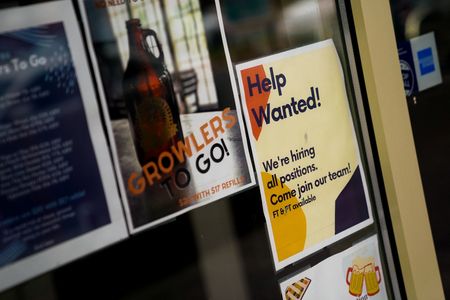By Lucia Mutikani
WASHINGTON (Reuters) – U.S. employment increased by the most in eight months in September as hiring rose broadly, pointing to persistent labor market strength that could give the Federal Reserve ammunition to raise interest rates again, though wage growth is slowing.
The larger-than-expected surge in nonfarm payrolls last month and sharp upward revisions to July and August’s jobs counts reported by the Labor Department in its closely watched employment report on Friday cemented expectations that economic activity accelerated in the third quarter.
The labor market and the broader economy’s resilience, 18 months after the U.S. central bank started raising rates to cool demand, suggest that monetary policy could remain tight for some time. The report followed news this week that job openings jumped in August and first-time applications for state unemployment benefits remained low in September.
Financial markets and most economists believe the Fed is probably done hiking rates because long-term U.S. Treasury yields have jumped to 16-year highs.
“With bond yields soaring, the dollar strengthening, and equity market volatility increasing there is a renewed tightening of financial conditions that does some of the work for the Fed, so it’s not a done deal the Fed hikes rates again,” said Kathy Bostjancic, chief economist at Nationwide.
Nonfarm payrolls increased by 336,000 jobs last month, the largest rise since January. The economy created 119,000 more jobs than previously reported in July and August. Payroll gains were almost double the 170,000 forecast by economists in a Reuters poll. The economy needs to create roughly 100,000 jobs per month to keep up with growth in the working-age population.
Some economists argued that payrolls had been boosted by difficulties adjusting the data for the return of education workers after the summer break, a notion dismissed by most since private payrolls increased by 263,000 jobs.
“The surge in teachers hired in September cannot belie the strength in payrolls now stretching back to July thanks to the biggest upward revisions to payrolls in a long time,” said Chris Low, chief economist at FHN Financial in New York.
The broad increase in payrolls was led by the leisure and hospitality industry, which added 96,000 jobs. Restaurants and bars dominated, with 61,000 positions created, returning employment in the sector back to its pre-pandemic level.
Government employment increased by 73,000 jobs, driven by state government education and local government, excluding education. Government employment remains below its pre-pandemic level by 9,000 jobs. The healthcare sector added 41,000 jobs, lifted by ambulatory healthcare services, hospitals, nursing and residential care facilities.
There were gains in professional, scientific and technical services employment, though temporary help hiring continued to decline. Employment in the transportation and warehousing industry rose as did retail and construction payrolls, mostly reflecting homebuilding despite mortgage rates being at more than 20-year highs.
There was no impact on payrolls from a strike by the United Auto Workers (UAW) at General Motors, Ford Motor and Chrysler parent Stellantis, which started at the end of the week that the government surveyed businesses for the employment report. Manufacturing payrolls increased by 17,000 jobs.
Employment in the motion picture and sound recording industries fell 7,000 jobs in part because of a recently ended months-long strike by Hollywood writers.
Stocks on Wall Street were trading higher. The dollar was lower against a basket of currencies. U.S. Treasury prices fell, with yields on the benchmark 10-year note and 30-year bond hitting levels last seen in 2007.
“This blockbuster report feeds into the higher (rates) for longer narrative,” said Gina Bolvin, president of Bolvin Wealth Management Group in Boston.
UNEMPLOYMENT RATE STEADY
Policymakers, eager to see labor market conditions easing, could draw some comfort from slowing wage growth. Average hourly earnings rose 0.2% after a similar gain in August. That lowered the annual increase in wages to 4.2%, the smallest gain since June 2021, from 4.3% in August.
The moderation in wages was likely because most of the jobs added last month were in lower-paying industries.
Nevertheless, wages are still rising faster than the 3.5% pace that economists say is consistent with the Fed’s 2% inflation target. But as fewer people quit their jobs in search of greener pastures, wage growth could moderate, though recent hefty union contracts pose a risk.
Financial markets were leaning toward the Fed keeping rates unchanged at its Oct. 31-Nov. 1 policy meeting, though the odds of a hike are rising, according to CME Group’s FedWatch tool. Inflation data next week could offer more clarity. Since March 2022, the Fed has raised its benchmark overnight interest rate by 525 basis points to the current 5.25%-5.50% range.
The unemployment rate was unchanged at an 18-month high of 3.8% in September as household employment rose modestly while more people entered the labor market.
But fewer people were working part-time for economic reasons, with the number dropping by 156,000.
As a result, a broader measure of unemployment, which includes people who want to work but have given up searching and those working part-time because they cannot find full-time employment, dropped to 7.0% from 7.1% in August. Fewer people were also experiencing longer spells of unemployment.
Labor market strength is helping to sustain the economy, with growth estimates for the third quarter as high as a 4.9% annualized pace, more than double what Fed officials regard as the non-inflationary rate of around 1.8%.
“While the typical worker may be experiencing a slower pace of wage growth, the still-solid rate of hiring suggests growth in aggregate income derived from the labor market continues on at a decent clip, which should support overall consumer spending,” said Sarah House, a senior economist at Wells Fargo in Charlotte, North Carolina.
(Reporting by Lucia Mutikani; Editing by Chizu Nomiyama and Andrea Ricci)

